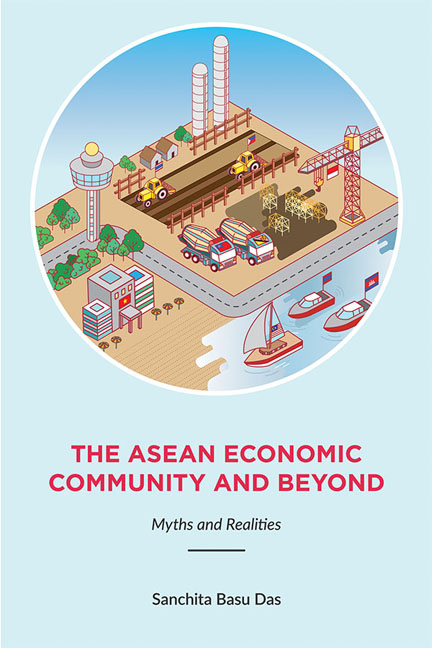Book contents
- Frontmatter
- Dedication
- Contents
- Foreword
- Acknowledgements
- Abbreviations
- 1 Introduction: The ASEAN Economic Community and Beyond
- I THE ASEAN ECONOMIC COMMUNITY (AEC)
- 2 The ASEAN Economic Community: An Economic and Strategic Project
- 3 Can the ASEAN Economic Community Be Achieved by 2015?
- 4 Goods to Flow Slow and Steady within the ASEAN Economic Community
- 5 The Limited Impact of the ASEAN Economic Community on Skilled Labour Migration
- 6 Five Facts About the ASEAN Economic Community
- 7 Growing Economic Diplomacy in ASEAN: Opportunities and Threats
- 8 Towards ASEAN Economic Community 2025!
- II BEYOND THE ASEAN ECONOMIC COMMUNITY
- III AN ASEAN PERSPECTIVE OF REGIONAL CONNECTIVITY
- Appendix: Summary of the Trans-pacific Partnership Agreement
- Index
- About the Author
2 - The ASEAN Economic Community: An Economic and Strategic Project
from I - THE ASEAN ECONOMIC COMMUNITY (AEC)
Published online by Cambridge University Press: 19 May 2017
- Frontmatter
- Dedication
- Contents
- Foreword
- Acknowledgements
- Abbreviations
- 1 Introduction: The ASEAN Economic Community and Beyond
- I THE ASEAN ECONOMIC COMMUNITY (AEC)
- 2 The ASEAN Economic Community: An Economic and Strategic Project
- 3 Can the ASEAN Economic Community Be Achieved by 2015?
- 4 Goods to Flow Slow and Steady within the ASEAN Economic Community
- 5 The Limited Impact of the ASEAN Economic Community on Skilled Labour Migration
- 6 Five Facts About the ASEAN Economic Community
- 7 Growing Economic Diplomacy in ASEAN: Opportunities and Threats
- 8 Towards ASEAN Economic Community 2025!
- II BEYOND THE ASEAN ECONOMIC COMMUNITY
- III AN ASEAN PERSPECTIVE OF REGIONAL CONNECTIVITY
- Appendix: Summary of the Trans-pacific Partnership Agreement
- Index
- About the Author
Summary
The ASEAN Economic Community (AEC) is both an economic and strategic initiative. As an economic project, the AEC is expected to achieve its objective of a single market by end-2015. Although ASEAN has achieved 82.1 per cent of its targets, it has not yet reached its end-goal since both border and beyond-the-border restrictions continue to prevail in the region. The elimination of such restrictions is likely to be the most important task if ASEAN intends to move towards a single market space in the future. As a strategic project, the AEC is conceived to help member states pursue their national interests. Economic cohesion is expected to help the ten small economies during times of economic vulnerabilities, to deliver on a bigger market space of 600 million people to attract FDI, and to play the role of a “hub” in the larger Asian region. In addition, economic coherence is likely to strengthen the member states’ bargaining power in the WTO and in their collective negotiating position for FTAs and other strategic matters. The AEC's achievement as a strategic project can be observed in ASEAN states’ increasing level of FDI; cooperative stance during the 2008 crisis; positive behaviour in dealing with the international community; and increasing belief in maintaining centrality. Going forward, the AEC process will continue, not just for its economic benefits of lowering trade and investment costs in the region, but also for managing ongoing economic and geopolitical uncertainties.
INTRODUCTION
As we begin 2015, attention turns to the ten Southeast Asian nations and their concrete “deliverable” of an ASEAN Economic Community (AEC) on 31 December. Understandably, questions have been raised as to whether the AEC can be successfully achieved. This paper tries to provide an answer to this by arguing that one should not judge the AEC solely by its economic outcomes and the issue of whether the AEC can be attained in its entirety by the deadline. Rather, one should also evaluate the AEC against its ability to serve the region's strategic goals of economic coherence in dealing with the international community as well as maintaining ASEAN centrality.
- Type
- Chapter
- Information
- The ASEAN Economic Community and BeyondMyths and Realities, pp. 11 - 22Publisher: ISEAS–Yusof Ishak InstitutePrint publication year: 2015



